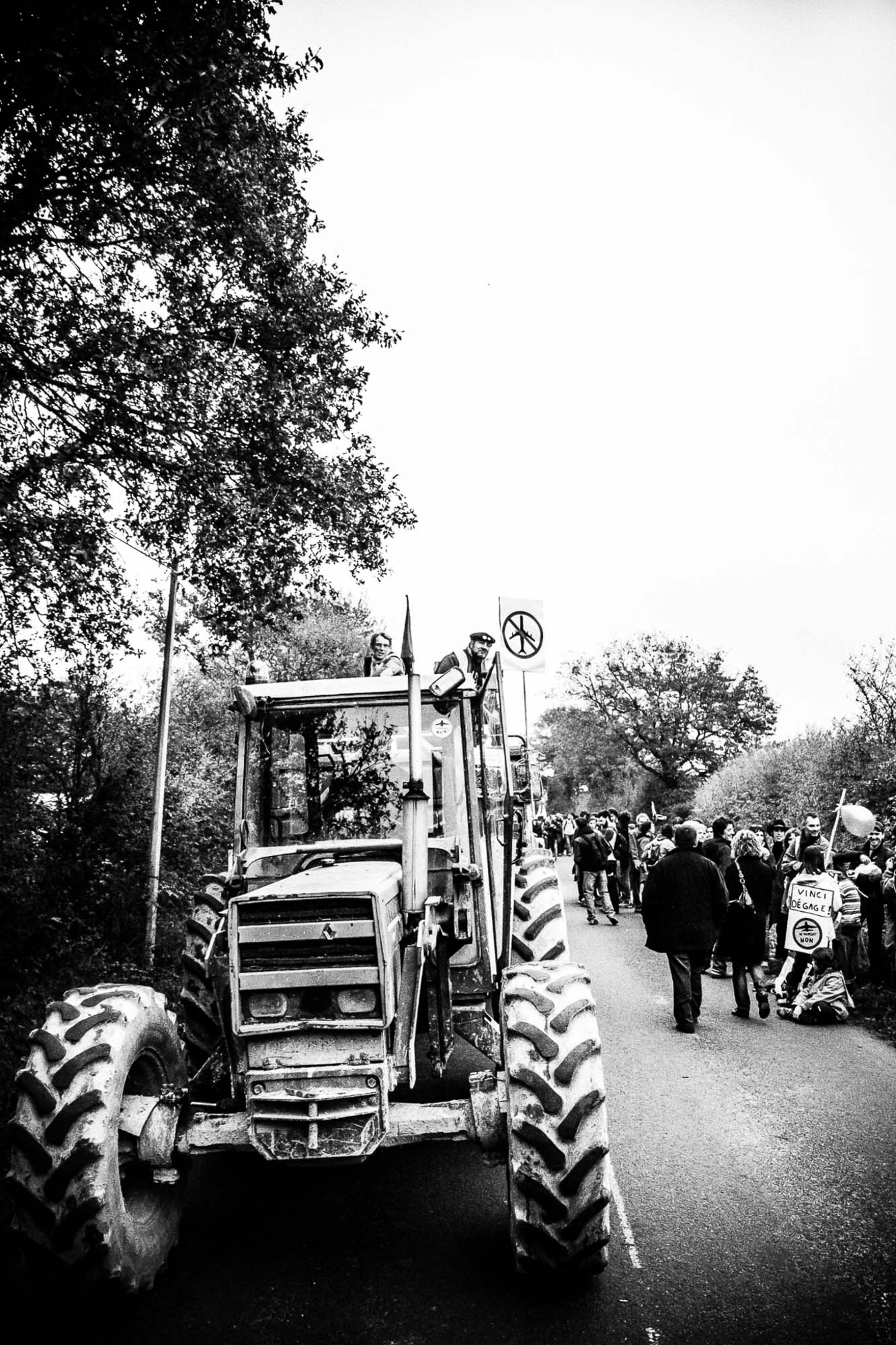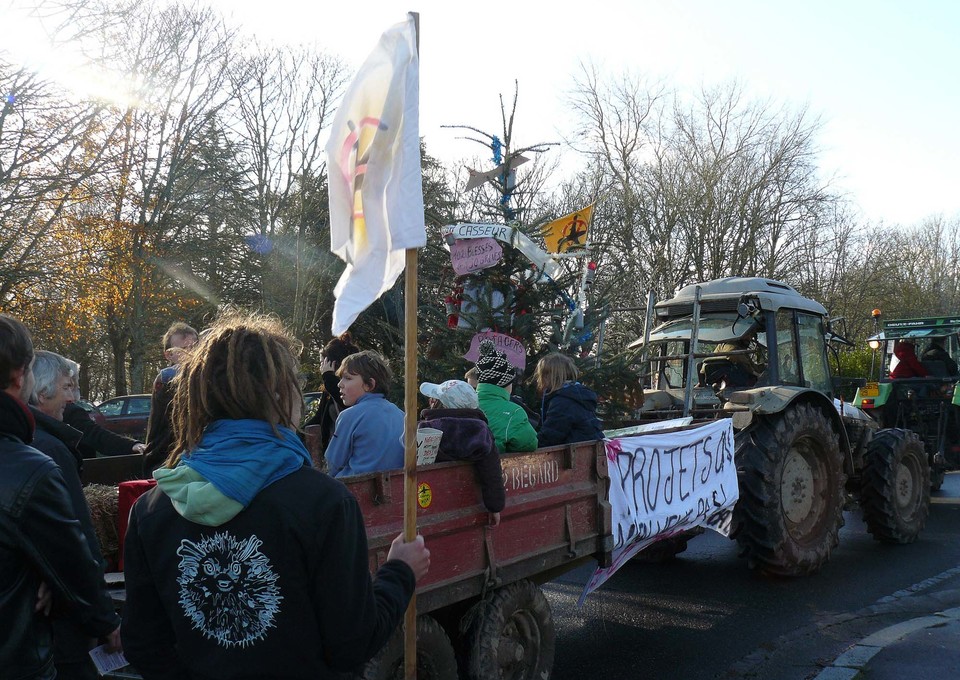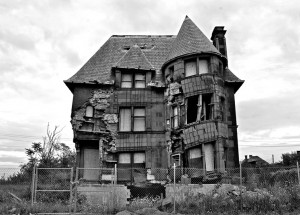This is part one of a two-part series on the Notre-Dame-des-Landes Zad, in Western France. The largest autonomous zone in Europe, the Notre-Dame-des-Landes Zad is the site of a remarkable long-term struggle against development, and a unique experiment in communal living.
Part 1: Introducing the zad, and the battle of 2012
For nearly 50 years, farmers, locals and activists have resisted the building of a new airport near the French city of Nantes. Out of the resistance, in the rich fields, forests and wetlands to the north west of the city, which the multinational construction company Vinci want to cover in concrete, an experiment in reinventing everyday life in struggle has blossomed. The land has been a gathering point for radicals from around the world – local farmers and villagers, citizen groups, trade unionists and naturalists, refugees and runaways, squatters and climate justice activists – who have come together to protect the 4000 acres of land against the airport and its world. Government officials have coined this place “a territory lost to the republic”. Its occupants have named it la zad (zone a défendre): a zone to defend.
Since the first protests against it in the 1970s, and following the project’s revival in the early 2000s, the airport has become increasingly unpopular, thanks to years worth of independent studies and alternative information. Every year that passes sharpens our prying eyes and pierces the blindness. From towns to villages, people begin to speak out and the issues converge: climate breakdown, protecting agricultural land, safeguarding biodiversity and defending sites of resistance from the consumer desert that spreads from the metropolis.
As the French state has royally ignored the very laws of which they are meant to be the guarantor, anti-airport organisations like ACIPA have brought the struggle into the courts. For years they have meticulously erected bureaucratic barricades of paperwork to delay the start of the construction. One by one, however, nearly all the court cases filed against the airport have been rejected by the courts. On most other fronts, eventually even the most raggedly determined end up admitting defeat and yielding to the ‘inevitable’ march of progress. But in the fields and forests of the zad, those who inhabit the land go on, refusing to surrender and make way for a construction site. At every turn, the beginning of the airport’s construction – preliminary surveys, test drilling and boring, the procedures for “environmental offsets and compensation” – are systematically blocked and sabotaged.
In the winter of 2012, thousands of riot police attempted to evict the zone, in an action the police dubbed “Operation Cesar”. They faced a determined and diverse resistance, culminating in a 40,000-strong demonstration to rebuild some of what had been destroyed by the French state. Less than a week later, the police were forced to stop Operation Cesar.
In 2016, after a small majority of voters approved the project via a local (and illegitimate) referendum, the entire zone was due for expulsions to start the construction of this absurd airport. Then Prime Minister Valls promised a “Rendez Vous” in October to evict everyone living, working, building and farming on the zone.
Instead, on October 8th, tens of thousands of people gathered on the zad to demonstrate that the movement is as strong and determined as ever. Honouring farmers’ struggles from the past, protesters came with wooden walking staffs and left them on the zad, as a sign of the commitment to come back and pick them up again if necessary. As of this writing, there have been no evictions.
‡
Since 2009, the zad has become an extraordinary laboratory of new ways of living, rooted in collaborations between all those who make up this diverse movement. The zad has become a space where different ways of inhabiting this world – fully and generously – are invented in the here and now. It is a place of hope, a hope rooted in histories we hold in common, enriched by the momentum of tens of thousands of rebels and relationships woven thick by time.
The zad’s inhabitants have worked together to radically rethink how to organise and work the land without an airport, based on the creation of commons, the notion of usage rather than property and the demand that those who fought for the land are those who decide its use.
We are groups of “squatters” who steadily arrived in the bocage following the invitation from the “residents in resistance” collective. We became attached to these lands in resistance, to the winding paths that we wander searching for mushrooms and blackberries, to the adventures and celebrations, to the collective work days.
We are the original residents and farmers of the zad. For us the idea of leaving this place has always been inconceivable. Despite the never ending pressure and the precariousness of an unknown future, we resisted this long so that we could keep the gardens that we tend, the ties with our neighbours, the farms that work to the rhythm of the milking hours and the joy that the ever-changing light of the bocage gives us. We were not directly threatened by the first wave of evictions thanks to a deal that was struck at the end of a long hunger strike in 2012. But without hesitation, we opened our homes and barns, turning them into refuges and logistics bases, from where we can resist together.
We are from the surroundings, some seasoned activists, others farmers in solidarity or just neighbours suddenly disgusted by the situation. We meet in a barn called “la Vache-rit" deeply convinced that in this moment we have an active role to play. We are armed with piles of dry socks, cameras to film the evictions and police violence, banners and pens to write angry letters, and chainsaws to reinforce the barricades with a few sacrificial trees. Among us are many elders carried by the memories of fierce struggles that this region has seen, resistance which has already cost “France’s economic power” dearly, such as the cancelling of three planned nuclear power stations in the last 20 years, at Plogoff, le Pellerin and le Carnet. We, too, are facing the gendarmes, our bodies blocking the roads.
We are a community of struggle coming into being.
‡
It is autumn 2012 in the bocage of Notre-Dame-des-Landes. It is the moment when all eyes turn towards this struggle against an airport project that is due to land on more than 4000 acres of wetlands, farmland and hamlets.
Early in the morning of the 16th of October, on a country lane bordered by hedgerows and engulfed by a fog of tear gas, a never ending column of riot vans sets off. This armada leads the demolition machines that have come to rip down dozens of farms and squatted cabins, that, according to the eviction order received a few months before, are “without rights or deeds”.
The state seems to have everything on its side. Of course this airport will bring jobs, growth and even security; in a word, it stands for all the fetishes peddled and guarded by those who govern over us. But awareness about the airport and its world has spread, and for more and more people it now seems to be just a way to line the pockets of the bosses of the public works and construction industry, especially the main contractor and builder of the project, Vinci.
In the weeks leading up to the 16th, in the offices of the prefecture, where the project of the Great Western Airport is being dealt with, a police operation aiming to secure the area for the start of the construction is being planned. Some bright spark, brimming with arrogance, has the absurd idea of calling the intervention Operation Cesar, which is fitting for this land of Asterix.
At first the barricades between us and the cops feel like frail structures. Built out of junk in the speed of the night from the carcasses of old cars and used tyres, hay bales and everything we can get our hands on, what materialises from them is, above all, an increasing intractableness.
We frantically run around our homes and cabins wielding makeshift shields and climbing gear to perch in the treetops, with stones, fireworks and a few Molotov cocktails to push back the assaults, lemons to protect ourselves from the tear gas and laptops to counter the mainstream media propaganda. We run and run, in the deep mud, breathless, trying to hamper the police’s manoeuvres and then we vanish behind the hedgerows and into the thickets that we have got to know so well. We wait for hours under the pouring rain crouching behind barricades that burst into flames as the troops approach.
Our first victory during those endless days and nights is that, faced with such a vast deployment whose sole objective is to corner us into giving up and running away, we hold our ground, whatever the costs. Our first victory is that we defend ourselves.
Despite this, several of the zad’s buildings are rapidly reduced to ruin; even the last bits of rubble are taken away in a skip. It’s as if they wanted to cleanse even the final fragments of our memories. But many other places under threat remain standing.
No one can pretend that they did not feel the fear and the doubts, the fragility that shuddered through us during those times. But then comes a moment where a shared certainty emerges, that if there is the slightest chance, however small, to be able to influence the situation that we are living through, then we must grab it. That certainty enables us to overcome the sleepless nights, the thick mud, police projectiles and the damp. It lets us keep our heads high and accept that resistance is always a gamble. In that autumn of 2012, once the dice are thrown, everything accelerates.
Every day during the autumn, more and more people come to the zad. The to-ing and fro-ing across the zone, along with our ever-fluctuating improvised logistics, means that the amount of vital stocks never ceases to change, yet never threatens to run dry. Night after night the barricades become more imposing, tirelessly rebuilt after every assault. Thousands of people spend their days living through the rhythm of the events via the live news updates on the zad’s website.
At the market garden of Le Sabot, and then at the squatted farm Le Rosier, farmers from the four corners of the region, brought together by the collective COPAIN, throw themselves wholeheartedly into battle. Their “vigilant tractors” multiply the material force of the movement, piling up bales of hay and pylons to block the lanes or encircling threatened buildings to protect them. The spirit of revolt that once breathed life into this region – from the farm-workers movement of the 1960s and 70s, which, together with the farmers whose livelihoods were threatened by the airport, contributed to the start of the struggle against the development – seems to be rumbling in the fields of Loire-Atlantique again.
Local committees spring up across France, over 200 of them. They coordinate transport to get people on the ground and organise all kinds of solidarity actions at home: distributing alternative information, occupying town halls, rowdy visits to local branches of the Socialist party, opening up the Vinci toll barriers to provide free transport for motorway users, sabotaging building sites, holding demonstrations and gatherings. Every one of these gestures spreads the struggle to the national level and gives it a new dimension, the scale of which we only really become aware of during the reoccupation demonstration.
The demonstration is a strategic gamble to shift the stakes of the struggle. It is no longer just about preparing to resist the evictions, but about showing that even if they manage to drive us out, we would return with many more, and build something even more powerful.
On the 17th of November 2012, following four weeks of demolitions and clashes, the cops melt away from the landscape and the space opens up for a human tide of 40,000 people. At the start of the demonstration, the little village of Notre-Dame-des-Landes is so totally taken over by the crowd that it seems that the hundreds of tractors might not even be able to leave and join in the march. A few kilometers up the road, we see countless planks and joists being passed from hand to hand and disappearing into the forest.
Nestled in the heart of a chestnut grove, a village has risen up from the ground in a single day, with its kitchen and workshop, dormitories and meeting rooms, its “Black Bloc Sanitaire” shower block and compost loos, and its “NO TAVern”, a boozer named after our sister struggle in the Val de Susa, against the high speed train line (Treno Alta Velocita). For several months this new village, “La Chat-teigne”, as it’s known, becomes a rallying point for local committees, who take turns living there.
That night tens of thousands return home with the sense that we have slain Cesar and changed the course of history. Dozens of us find it just impossible to leave, so gripped by the intensity of the adventure that we are ready to desert our jobs and homes.
By the end of November, what has taken place at the zad has become so huge that this piece of territory, suspended in time, becomes a daily topic of debate. From the front pages of the local press to headlines in the national media, from discussions in the pub to meetings in high places, the zad becomes the temporary heart of French political life.
Then, before dawn on Friday the 23rd, a group of mobile gendarmes silently penetrates the heart of the zad. In the dormitories bodies are swaddled in sleeping bags, packed into tight rows and resting from the great party the night before. The lookouts on the barricades ring the alarm, but it’s too late. By the time everyone has dragged themselves out of deep sleep, put on wet socks and the now iconic muddy boots, the troops are in position around the cabins of la Chat-teigne. A smashed window and a few generous whiffs of tear gas and we are chased into the darkness of the surrounding forest.
Before the week is up the authorities want to take back control and wash away the humiliation of the reoccupation demonstration. As the sun rises the tragedy is revealed. La Chat-teigne is entirely in the hands of the cops. At Le Rosier, the vigilant tractors have been unable to stop the bulldozers, who soon rip into the building. In the forest of Rohanne, suspended between earth and sky, a band of tenacious friends twist and turn, hanging on the ends of ropes that tie them to the highest trees. On the ground small groups of gendarmes escort machines that have come once again to destroy the tree houses perched in the branches. Constructed to physically prevent the forest clearance, the first phase of the works planned to happen just after the evictions, the treehouses have already been rebuilt several times this over the last few weeks after police attacks.
The news spreads. Many of those who left a week before with a little bit of the zad still inside them return immediately to the forest. There are now hundreds of us finding ourselves amid the gas and the mist. We hold ourselves together. We dance in devilish circles at the foot of the trees to which comrades are hanging on tight, to torment the police escorting the machines coming to turn the forest into sawdust. Brushing close to the cops, we provoke and disorient them with the tune of a traditional Breton song, or our curses. We sing, we discuss, we scream, we fight, we cry, we hug.
On the other side the orders are clear: you have to mark their flesh, to break their irrepressible desire for disobedience. After the battle we count the wounded: a hundred of us, of whom some thirty have serious wounds and injuries, all received during Saturday alone. The shrapnel blasts from grenades, the same type that would kill Remi Fraisse two years later on another zad at Sivens, pierce our bodies, shards sticking out of our skin. But there is no question of backing down, and every strike only reinforces our resolve.
The conflict spreads beyond the forest. It is contagious. On Friday night dozens of tractors converge on the four crossing points of the Loire river, downstream from Nantes. As the evening sets in, they block Nantes’ Cheviré and Saint-Nazaire bridges and the ferries of the Pellerin and Basse-Indres. On Saturday, in front of the Prefecture of Nantes, 10,000 people take to the streets and throw themselves at the water cannon brought out for the occasion.
Finally, night falls in the forest of Rohanne, and we witness the disorderly retreat of the police under projectiles and wolf howls. While we are wondering what this withdrawal means, we hear on the radio that the government has announced the end of Operation Cesar.
This piece was adapted from ‘Defending the Zad’, which can be read here. Part 2 to follow next week.
Gallery





